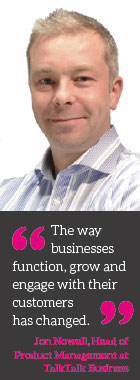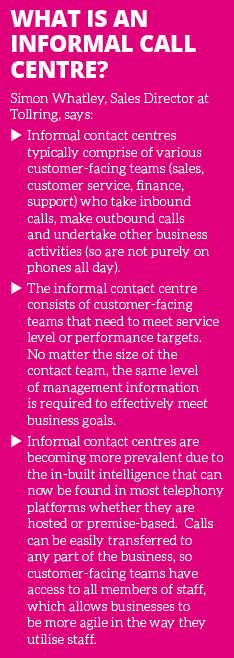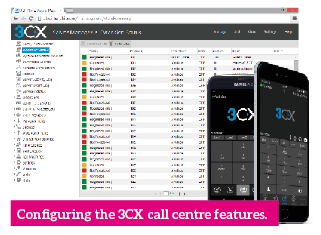
Comms Business Magazine examines the informal call centre market and concludes that whilst the size of the call centre may be small there is no reason why it should not be perfectly formed.
Informal call centres; it’s a question of scale isn’t it? You have a few staff answering the phones and when you get bigger you have a full-blown call and contact centre. Simple. But, and there’s always a but, what if you are one of the majority of organisations that sit somewhere in the middle of this scale? For you, one solution may not be up to the job and the big technology one is probably overkill as well as being too darn expensive to purchase and manage.
Enter the informal call centre. A set of low cost features with elementary management reporting should do the job quite nicely until the firm hits the mother lode and expands. Well it should – but does it? And can an incumbent PBX provide those features or would you be far better off getting a scalable cloud based solution that can grow (or contract) with your needs?
So all of a sudden it’s not that easy is it? How can resellers judge where to position their end user offerings to the betterment of their client’s productivity?
Buy it Once!
Phillip Reynolds, Joint CEO at Oak, says it is very difficult for him to comment without plugging his new Contact Centre Reporting solution, Evolve.
“This is because we have conquered the divide between a low entry cost solution that you would need for an informal call centre through to a medium sized call centre of 200 agents at an affordable price, and the software grows as the end user’s business grows.
 Yes the high-end call centres have specialist software at very high prices but beneath that is a raft of business opportunity for informal and formal call centre sales. Yes you might get very sophisticated call routing at the top end but for most, standard hunt group and agent working will be more than enough. Tie this together with powerful reporting and management software and you have the complete package. The way software is licensed in this market is on a per seat basis so you only pay for what you need when you need it. As your business grows and you move from informal to formal working (agents logging in/out, adding wrap up time to calls), so does the software and the feature set you need.
Yes the high-end call centres have specialist software at very high prices but beneath that is a raft of business opportunity for informal and formal call centre sales. Yes you might get very sophisticated call routing at the top end but for most, standard hunt group and agent working will be more than enough. Tie this together with powerful reporting and management software and you have the complete package. The way software is licensed in this market is on a per seat basis so you only pay for what you need when you need it. As your business grows and you move from informal to formal working (agents logging in/out, adding wrap up time to calls), so does the software and the feature set you need.
In terms of telephone systems, they all come with some form of hunt group or queue option as standard. This could be a simple ringing group or a more advanced group where calls are routed to the person who’s been off the phone the longest. Where you want to step up to the next level and have agent working then you will need additional paid for options on the telephone system. The telephone system though will be running your whole business and the call centre part will normally comprise of a small number of extensions within your phone system. You may for example have 100 extensions of which 20 are being used for telesales or customer support, the rest are just normal use extensions. This means you can update your existing phone system to give you what you need.
So from a reseller perspective you can focus on the switch capabilities and look to bolt on a powerful reporting and management solution as necessary. If they were to choose Oak’s Evolve then they would only need to buy it once and simply add seat licences as and when required.
My view is that every business is a call centre and should be sold to on that basis from day one. Most switches are scalable so that shouldn’t be an issue either.”
Jon Nowell, Head of Product Management at TalkTalk Business, says that the way businesses function, grow and engage with their customers has changed, meaning many have ended up somewhere in the middle of the call centre scale.
“The telecoms industry has responded strongly with a range of innovative options to meet business demands, from PBX to hosted solutions. While all these solutions have benefits, selecting the right one can be difficult, especially as no two companies’ requirements are the same.
An added challenge is the increasing demand for a myriad of services to be included in one, easy to deploy solution. Choosing the correct solution, ultimately, comes down to the environment it will be used in – factors such as current and future business requirements and client demand will all influence the decision.
Next generation technology means that PBX can be moved onto SIP Trunking, which delivers cost savings as well as the standard overlay services. However, the channel can also look to hosted solutions, which offer a long-term alternative to the infrastructure-heavy, hardware-based PBX systems. Hosted solutions give additional flexibility to businesses, meaning they can grow as and when they need. Importantly for the channel, hosted call centres provide high-margin opportunities that bring increased productivity and critically significant cost benefits to the end user.”
Simon Whatley, Sales Director at Tollring perceives the informal contact centre SME space to be in the range of 5-30 seats (across multiple departments / contact points), and says this is a size rarely spoken about when discussing contact centre management, even though a huge number of businesses fit into this category – a huge untapped market for resellers.
 “Many businesses do not appreciate that they have an informal contact centre yet most will agree that more effective customer interactions are essential to every business.
“Many businesses do not appreciate that they have an informal contact centre yet most will agree that more effective customer interactions are essential to every business.
Whether a hosted or PBX system is chosen by the customer, a scalable informal contact centre can easily be achieved when integrated with call management such as iCall Suite. Tollring has developed a unique level of integration with Samsung OfficeServ or the ELG iPECS specifically for informal contact centres. For hosted telephony, the same levels of integration have been developed for the BroadWorks and Mitel MiCloud platforms.”
Getting the Right Balance
Steve Tutt at VanillaIP looks to the rise of cloud based call and contact centres in making highly featured solutions available to the smaller user.
“One advantage of the cloud as a service delivery model is the democratisation of feature availability. Informal call centres are among the best examples of this, where previously, advanced routing and reporting were simply not available without investment in larger systems. This precluded their deployment in the SMB, the natural habitat of the informal call centre. The evolution of informal call centres was partly because of a more relaxed behavioural approach but also simply because call centre tech could not scale down sufficiently.
Cloud has totally changed this with the ability to deliver service on per user, or per Agent basis. A significant trend we have seen in informal environments is the adoption of home worker Agents, often working short peak-hour shifts. Looking at the retail travel vertical for example, customers often research their holidays during the day and ring up to book them at night. So 6pm-8pm is the money shift. Our Cloud Call Centre provides the elasticity to scale up home worker Agents for exactly this type of scenario.
Because a call centre is informal it doesn’t mean they don’t want to track performance. The key is to get the balance right. Customers might not think they want a “call centre” but they still want to maximise customer service by getting the calls to the right people quickly and measuring what’s happening. That’s what our Cloud Call Centre gives them and there is a whole continuum of sophistication and detail if they need to grow into that.”
David Rowlands, UK and EMEA Head of Virtual Contact Centres at 8x8 Solutions, takes a similar view when he says it is important that vendors provide tailored and scalable solutions to all size businesses that help them grow and meet customer demand.
“Cloud based solutions are brilliant because they enable businesses of any size to take advantage of the features that would previously have only been available to large Blue Chip companies, without a big initial outlay.
Enter the informal call centre. A set of low cost features with elementary management reporting should do the job quite nicely until the firm hits the mother lode and expands. Well it should – but does it?
It is true that a lot of solutions provide only basic features to smaller companies; however, with 8x8, we believe that all businesses should have access to the same advanced features. This is incredibly useful for ambitious businesses, which can use these features to give the illusion of being a much larger company than they are. Businesses should feel reassured that they can expect the same exacting standards of customer service and service provisions from day one onwards.
PBX solutions simply cannot adapt in the same way that cloud-based solutions can. Many of our customers, for example in the hospitality industry, experience seasonal surges in demand. So the ability to quickly add (or remove) new call handlers is critical to maintaining high levels of professional customer service across the year. Only cloud-based solutions offer that flexibility. However, it is not just in terms of scalability that cloud solutions are superior to legacy PBX systems. With our solutions, new features and updates can be implemented at the click of a button, with no need to rip out and replace expensive hardware.”
Increase Productivity
Bianca Allery, Marketing Manager at 3CX, says her company has been providing both informal call centres and larger established call centres with robust call management systems for years, with 3CX Phone System Pro.
“It’s the ideal low cost way to enter a call centre solution, as it’s highly scalable. The latest version includes a range of features designed to save time, maximise productivity, and help call centre managers efficiently manage their team.
Enterprise-grade call centre features not only mean improvements internally, such as better productivity via Microsoft Exchange and popular CRM integration, but also externally customers will notice an improved service.”
Allery says resellers should look out for key features such as Microsoft Exchange / LDAP Integration for integration with a company’s Exchange 2013 phone book to instantly show who’s calling them and CRM integration with the likes of Microsoft Outlook, Microsoft Office 365, Salesforce, Microsoft Dynamics, Sage ACT!, SugarCRM and Google Contacts.
She adds, “Look for cross-office presence to increase productivity. By allowing users to see the presence of their colleagues in other offices using the 3CXPhone for Windows, Android and iPhone clients users can boost productivity as employees can communicate amongst themselves more effectively.”
Reseller Advice:
Resellers have a busy time of it these days according to Tom McKinlay, Presales Consultant at Sytel.
“Their product and service offerings have to cater for a wide range of technologies, simultaneously. ‘Must-have’ features vary from client to client; the location of clients’ agents may be widely spread plus their clients’ end customers may want to use different methods of communication such as; voice, chat, email, sms and social media.
Resellers must be aware of all these and have the flexibility to cater for them. We are seeing many contact centres employ agents on a skills basis which often means the agent is not located in the same building, town or even the same country as the contact centre. Hosted services definitely provide the fastest and smoothest way for resellers to scale up or down as the client requirements change. No longer are there delays while hardware is ordered, delivered and installed in to the client’s premises.
The smart resellers are also making their pricing models flexible, the days of ‘locked-in’ price contracts are gone. Clients want to pay for what they use, not what they plan/hope to grow into. This removes the pain of paying in advance for expansion that isn’t achieved or providing a poor customer service because the contact centre hasn’t been able to upscale to meet their customers’ demands.
 The increasing use of multimedia means the features offered by the reseller must allow the client to handle multiple communication types. In line with this, it is also crucial for agents to be quickly and easily assigned to different tasks dependant on the demands of the different media streams. If one media stream spikes unexpectedly it is imperative that agents can be smoothly redirected to avoid sessions going in to jeopardy.
The increasing use of multimedia means the features offered by the reseller must allow the client to handle multiple communication types. In line with this, it is also crucial for agents to be quickly and easily assigned to different tasks dependant on the demands of the different media streams. If one media stream spikes unexpectedly it is imperative that agents can be smoothly redirected to avoid sessions going in to jeopardy.
This must go hand in hand with quality reporting; the client’s productivity where SLAs are involved needs to be accurately reported on. Supervisors moving agents between media types to keep responses within given SLAs is all very well, but the process needs to be recorded and reports easily extracted so the client can closely monitor their own productivity.
Providing the means to analyse and plan is crucial for the resellers’ clients. The role of the reseller is to provide maximum flexibility of their services for their clients with comprehensive reporting intrinsically linked.”
Ed Says…
There’s no doubt that the Enterprise class call and contact centre bells and whistles are now available in an affordable form for the smaller informal call centres – especially in SaaS delivery models. As Tom McKinlay of Sytel says, resellers will have a busy time sorting out what to recommend for their clients.
